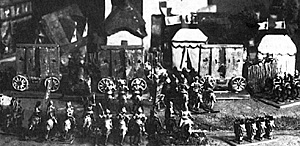When I first read Lynn Montross' account of the Hussite "wagon-forts" I thought of the potential for challenging wargaming. He told how "a
peasant army from Eastern Europe discarded its flails and led the entire continent in the creation of a tactical system based on weapons of gunpowder."
Follow the Wargame Drum
Over the years I have known many people who "follow the wargame
drum". Most of them are a mixture of collector, gamester, rulesmith,
historian, mid handcrafter. The handcrafters include those who paint, convert,
design, Sculpt, mid cast figures as well as those who make all the realistic
scenery, terrain and odd details that have such appeal to those of us who
view wargaming as a "moving diorama". Nevertheless, since most
of the war gaming books and magazine articles deal with rules for movement,
melee and morale of the troops, this article is intended to encourage beginning
handcrafters and give the "old hands" a few ideas for improving
what Charles Grant called the "look of the thing". Handcrafters enjoy making the war game equipment they need. Some things that I have made include tents, walls and wagons. The tent is a real all-purpose model that can be painted for virtually any period. I found I needed the palisade wall section for my DBA "camps". The baggage wagons can be used for both camps and convoys. These pictured are scaled for 25/30mm, but such castings could be scaled for 15mm figures as well.
While these special features for your games that may not be available or affordable on the market, they can be made of plaster of Paris, cast in latex molds from odds-and-ends patterns (wood blocks, cardboard, modeling clay etc.) and then Painted to set the stage for your games. Handcrafters know that when you make it yourself you can have exactly what you want and you can fix it when it breaks. Wargamers who have seen the diorama Museum pieces" may hesitate
to build their own because they confuse the beautiful, meticulous "scale
models" with what I have come to think of as stage models". In the theatre, the "stage settings" provide backgrounds for,
but should not outshine, the "actors". On the war game table
the finest details of casting and painting are usually in the miniature
figures. The houses and equipment with "Suggested" details and
softer, more weathered colors, provide the settings. I remember Charles
Grant as one of the "moving diorama" folks. In The War Game,
he recalls the importance of "the look of the thing" and the
pleasure connected with "realistic-looking buildings from the period
point of view". That is, we need stone or wattle-and-daub thatched
huts for ancients, timber-frame and stone houses for medieval, and log
cabins, brick and clap-board farm houses for the Civil War. The handcrafter/wargamers
who build their own can have these things and in their wargames are also
able, as Grant said, to "see the effect of action in built up areas
and see the effect of their skill or luck with field guns or howitzers". Case Study of a Hussite Wagon-Fort
 I had read enough to have a general idea of the wagon-fort construction,
four-wheel wagons with heavy wooden mantlets or shields with loop holes
to offer the primitive handgunners a rest for a steady aim and shelter
from missiles, but the thought of scratch-building enough of them for a
wargame was overwhelming mid I have never seen such a specialized item
listed in a commercial catalogue. This is the sort of means/ends situation
where being a "handcrafter" pays off.
I had read enough to have a general idea of the wagon-fort construction,
four-wheel wagons with heavy wooden mantlets or shields with loop holes
to offer the primitive handgunners a rest for a steady aim and shelter
from missiles, but the thought of scratch-building enough of them for a
wargame was overwhelming mid I have never seen such a specialized item
listed in a commercial catalogue. This is the sort of means/ends situation
where being a "handcrafter" pays off.
Back to Table of Contents -- Courier #63
Back to Courier List of Issues
Back to Master Magazine List
© Copyright 1993 by The Courier Publishing Company.
This article appears in MagWeb (Magazine Web) on the Internet World Wide Web.
Other military history articles and gaming articles are available at http://www.magweb.com